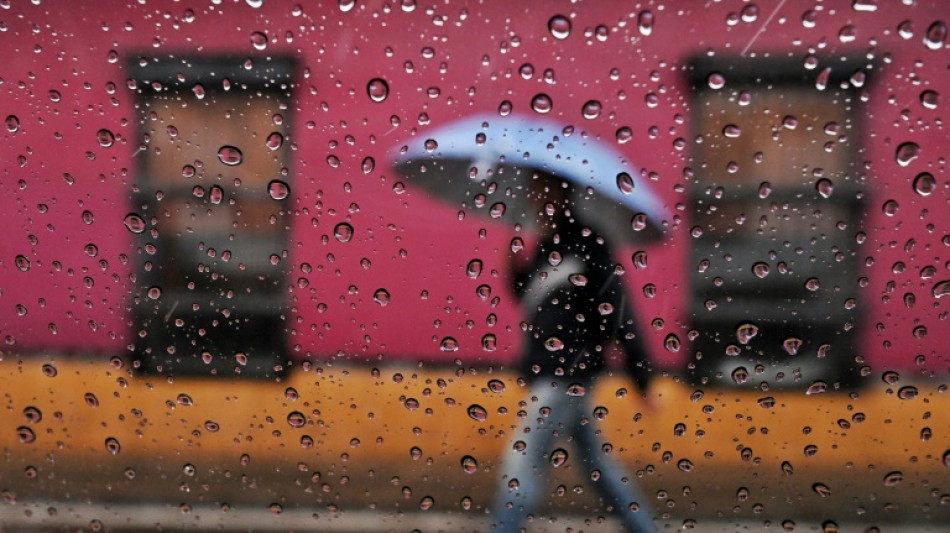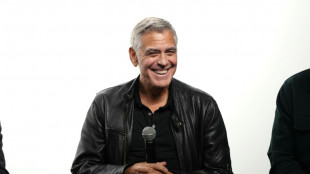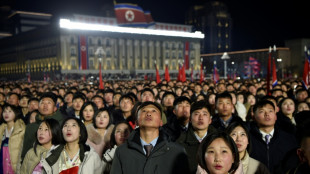
-
 Osaka drawing inspiration from family at United Cup
Osaka drawing inspiration from family at United Cup
-
Leftist Mamdani takes over as New York mayor under Trump shadow

-
 Israel's Netanyahu among partygoers at Trump's New Year's Eve fete
Israel's Netanyahu among partygoers at Trump's New Year's Eve fete
-
Champagnie, Wemby lead Spurs comeback in Knicks thriller

-
 Eight dead in US strikes on alleged drug boats: US military
Eight dead in US strikes on alleged drug boats: US military
-
Trump joins criticism of Clooney's French passport

-
 AI, chips boom sent South Korea exports soaring in 2025
AI, chips boom sent South Korea exports soaring in 2025
-
Taiwan's president vows to defend sovereignty after China drills

-
 N. Korea's Kim hails 'invincible alliance' with Russia in New Year's letter
N. Korea's Kim hails 'invincible alliance' with Russia in New Year's letter
-
In Venezuela, price of US dollar up 479 percent in a year

-
 Cummins, Hazlewood in spin-heavy Australia squad for T20 World Cup
Cummins, Hazlewood in spin-heavy Australia squad for T20 World Cup
-
Ex-boxing champ Joshua discharged from hospital after fatal car crash

-
 Zelensky says deal to end war '10 percent' away
Zelensky says deal to end war '10 percent' away
-
Trump bashes Clooney after actor becomes French

-
 We are '10 percent' away from peace, Zelensky tells Ukrainians
We are '10 percent' away from peace, Zelensky tells Ukrainians
-
Trump says pulling National Guard from three cities -- for now

-
 Ivory Coast top AFCON group ahead of Cameroon, Algeria win again
Ivory Coast top AFCON group ahead of Cameroon, Algeria win again
-
World welcomes 2026 after a year of Trump, truces and turmoil

-
 Ivory Coast fight back to pip Cameroon for top spot in AFCON group
Ivory Coast fight back to pip Cameroon for top spot in AFCON group
-
Second Patriots player facing assault charge

-
 Trump-hosted Kennedy Center awards gala ratings plummet
Trump-hosted Kennedy Center awards gala ratings plummet
-
Israel begins demolishing 25 buildings in West Bank camp

-
 Cambodian soldiers freed by Thailand receive hero's welcome
Cambodian soldiers freed by Thailand receive hero's welcome
-
Sudan lose to Burkina Faso as Algeria win again at Cup of Nations

-
 Man City's Rodri and Doku could return against Sunderland
Man City's Rodri and Doku could return against Sunderland
-
French minister criticises Clooney's 'double standard' passport

-
 Ukrainians wish for peace in 2026 -- and no more power cuts
Ukrainians wish for peace in 2026 -- and no more power cuts
-
Glasner coy over Palace pursuit of Spurs striker Johnson

-
 Neville labels Man Utd's draw with Wolves 'baddest of the bad'
Neville labels Man Utd's draw with Wolves 'baddest of the bad'
-
Stocks pull lower at end of record year for markets

-
 France plans social media ban for children under 15
France plans social media ban for children under 15
-
Mbappe suffers knee sprain in blow for Real Madrid

-
 Putin wishes Russians victory in Ukraine in New Year speech
Putin wishes Russians victory in Ukraine in New Year speech
-
Iran government building attacked as top prosecutor responds to protests

-
 World begins to welcome 2026 after a year of Trump, truces and turmoil
World begins to welcome 2026 after a year of Trump, truces and turmoil
-
Fofana reckons 'small details' restricting Chelsea's progress

-
 Israel to ban 37 aid groups operating in Gaza
Israel to ban 37 aid groups operating in Gaza
-
Filmmaker Panahi says Iran protests 'to move history forward'

-
 Xi says China to hit 2025 growth target of 'around 5 percent'
Xi says China to hit 2025 growth target of 'around 5 percent'
-
Turkey steps up anti-IS raids, arresting 125 suspects

-
 Arteta says Arsenal reaping rewards for 'sacrifices and commitment'
Arteta says Arsenal reaping rewards for 'sacrifices and commitment'
-
China says live-fire drills around Taiwan 'completed successfully'

-
 Nancy adamant he's still the man for Celtic job after Motherwell defeat
Nancy adamant he's still the man for Celtic job after Motherwell defeat
-
Hoping for better year ahead, Gazans bid farewell to 'nightmare' of 2025

-
 Queen Camilla recalls fighting back against train attacker
Queen Camilla recalls fighting back against train attacker
-
Stocks drop at end of record year for markets

-
 Amorim still 'really confident' about Man Utd potential despite Wolves draw
Amorim still 'really confident' about Man Utd potential despite Wolves draw
-
Berlin says decision postponed on European fighter jet

-
 Iran prosecutor pledges 'decisive' response if protests destabilise country
Iran prosecutor pledges 'decisive' response if protests destabilise country
-
Emery defends failure to shake hands with Arteta after Villa loss to Arsenal

| SCS | 0.12% | 16.14 | $ | |
| RBGPF | -0.37% | 80.75 | $ | |
| CMSD | 0.09% | 23.15 | $ | |
| RELX | -1.71% | 40.42 | $ | |
| NGG | -0.54% | 77.35 | $ | |
| RIO | -0.61% | 80.03 | $ | |
| CMSC | -0.15% | 22.65 | $ | |
| BCC | -0.26% | 73.6 | $ | |
| BCE | 1.05% | 23.82 | $ | |
| VOD | -0.15% | 13.21 | $ | |
| RYCEF | 0.13% | 15.51 | $ | |
| GSK | -0.53% | 49.04 | $ | |
| AZN | -0.63% | 91.93 | $ | |
| JRI | 0.22% | 13.61 | $ | |
| BTI | 0.12% | 56.62 | $ | |
| BP | -0.06% | 34.73 | $ |

What looming La Nina means for global temperatures
El Nino, the natural weather phenomenon that contributed to 2023 being the hottest year on record, has recently subsided, paving the way for its opposing, cooling La Nina phase to begin.
But in the context of a warming planet due to human-caused climate change, scientists say that cooling effect may be miniscule.
Here is how the cycle called El Nino-Southern Oscillation (ENSO) works to affect global weather:
- El Nino -
El Nino can weaken consistent trade winds that blow east to west across the tropical Pacific, influencing weather by affecting the movement of warm water across this vast ocean.
This weakening warms the usually cooler central and eastern sides of the ocean, altering rainfall over the equatorial Pacific and wind patterns that change temperature and rain around the world.
The extra heat at the surface of the Pacific releases energy into the atmosphere that can temporarily drive up global temperatures, which is why El Nino years are often among the warmest on record.
It occurs every two to seven years, and lasts nine to 12 months.
The latest El Nino, which began in June 2023, peaked among the five strongest such events on record, according to the World Meteorological Organization (WMO).
It typically results in drier conditions across southeast Asia, Australia, southern Africa, and northern South America, and conversely much wetter conditions in the Horn of Africa and the southern United States.
While it is unclear what impact climate change may be having on ENSO, it is affecting how these events play out, said Michelle L'Heureux, lead ENSO forecaster for the US NOAA weather agency.
Climate change is making extreme events more frequent and intense, and when colliding with ENSO can cause its associated drier or wetter conditions to "become more amplified", she added.
The elevated global temperatures ENSO causes also served as a "portal" into the future of climate change, L'Heureux said.
"It gives you... a bit of a preview of what a warmer world looks like because it is giving you a temporary boost. So we're now at a new level we haven't seen before," she said.
- Neutral period -
Although El Nino has been dissipating, the first four months of 2024 have continued to break heat records -- unsurprisingly as the cycle typically drives up temperatures the year after it develops.
ENSO is "not an on-off switch", L'Heureux explained. "It takes a while for the global atmospheric circulation to adjust."
Scientists anticipate that the neutral period between the two cycles will begin between May and July.
Above-normal temperatures are forecast to persist through July across the northern and southern hemispheres, with just equatorial regions anticipated to see near-to-below normal temperatures, according to WMO.
The neutral period is not likely to last long, L'Heureux explained.
Typically, after a strong El Nino as the world just experienced, La Nina soon follows.
- La Nina -
La Nina sees the eastern Pacific Ocean cool for a period of about one to three years, generating the opposite effects to El Nino on global weather.
It leads to wetter conditions in parts of Australia, southeast Asia, India, southeast Africa and northern Brazil, while causing drier conditions in parts of South America.
It can also contribute to more severe Atlantic hurricanes, and NOAA has forecast an "extraordinary" storm season ahead this year.
La Nina tends to bring down global temperatures, although L'Heureux warned against hopes of relief in areas like southeast Asia that have recently be battered by scorching heatwaves.
"The world is warming and ENSO is acting secondary to that," she said.
"Even this year with La Nina potentially developing, we're still expecting basically a top-five global mean temperature record," she said.
NOAA says there is a 69 percent chance of La Nina beginning sometime between July and September.
L.Miller--AMWN



